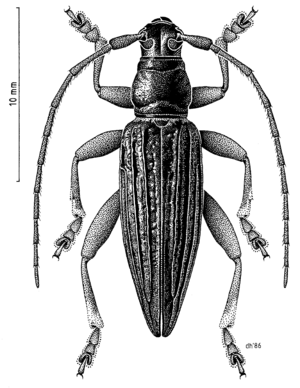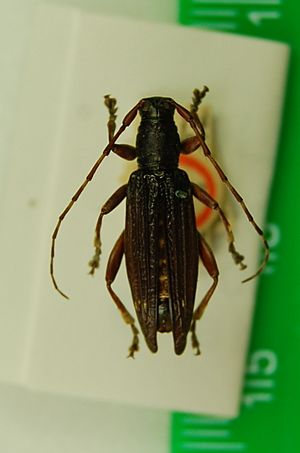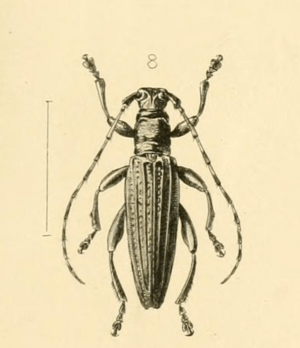Pitt Island longhorn beetle facts for kids
Quick facts for kids Pitt Island longhorn beetle |
|
|---|---|
 |
|
| Illustration by Des Helmore | |
| Conservation status | |
 Nationally Critical (NZ TCS) |
|
| Scientific classification | |
| Genus: |
Xylotoles
|
| Species: |
costatus
|
The Xylotoles costatus, also known as the Pitt Island longhorn beetle, is a special type of beetle. It belongs to a group called Cerambycidae. This beetle is found only in the Chatham Islands of New Zealand. For a long time, people thought it had died out completely. But luckily, it was found again on South East Island/Rangatira. This makes it a "Lazarus taxon", which means a species that was thought to be extinct but was later rediscovered.
Contents
Discovery and History

The Pitt Island longhorn beetle was first officially named in 1875. A scientist named Francis Polkinghorne Pascoe described it. He used male and female beetles collected by Henry H. Travers from Pitt Island.
One of the original beetles, called a type specimen, is kept at the Natural History Museum, London. The last time this beetle was collected before its rediscovery was between 1906 and 1908. A person named Thomas Hall found three beetles on Pitt Island. These beetles are now part of the New Zealand Arthropod Collection.
Description and Identification
It can be tricky to tell the Xylotoles costatus apart from another longhorn beetle. This other beetle, called Xylotoles traversii, also lives in the Chatham Islands. Both beetles are black and have a shiny green-bronze look.
However, the X. costatus usually has more of a bronze shine. It also has clearer ridges on its wing cases. The X. traversii is generally smaller. But their sizes can sometimes overlap. If you find a longhorn beetle in the Chatham Islands that is longer than 16 millimeters, it is probably an X. costatus.
Habitat
This type of longhorn beetle likes to live on the trunks of Coprosma chathamica trees. You can usually find them there at night. Adult beetles are also attracted to branches that have recently died or are dying.
Conservation and Threats
The X. costatus beetle cannot fly. It spends time moving around on the ground between trees. This makes it easy for animals like rats and mice to catch and eat it. Scientists believe it is important to learn exactly what kind of habitat the adult beetles and their young need. This information will help protect them.
The beetle has not been seen on Pitt Island since 1907. This is even though people have searched for it many times since 1990. After 1910, it was not seen again until 1987. All the beetles found since then have been on Rangatira. This island is located off the south-east coast of Pitt Island.
The X. costatus is the only longhorn beetle that is legally protected in New Zealand. This protection comes from the Wildlife Act 1953. It means it is against the law to kill, own, buy, or sell one of these beetles.
See also
 In Spanish: Xylotoles costatus para niños
In Spanish: Xylotoles costatus para niños



